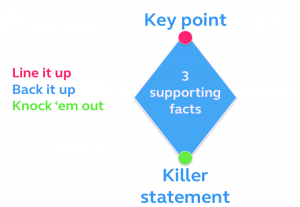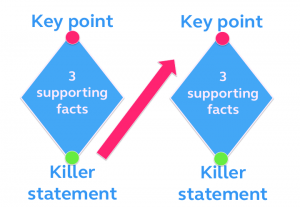Perfect Pitch: three tips for delivering a winning presentation
Blah blah blah. All too often this is what it is like. Someone is presenting something to you; they are pitching, promoting, selling, explaining and it just sounds like blah blah blah punctuated by lots of ummms and errrrs. They don’t get to the point. What is the point? The moment is lost and the pitch is lost.
It doesn’t have to be this way. If you are pitching or presenting to an unfamiliar audience, and want to make an impact, here are three top tips that will have you delivering winning pitches.
1. Understand sender-message-recipient
There are three parts to the pitch that you need to consider. The sender – that is you. The recipient – that’s who you are pitching it to. And the message – well that’s your pitch.
The recipient: Here’s the first thing to get right. Know your audience. Once you know who the recipient of your message is you can ensure that you tailor the message right. A little research about the recipient will go a long way; are they already familiar with your product / category / domain? Do they understand the technology. You don’t want your pitch to fail because they didn’t understand what you were talking about by drowning them in acronyms and industry-speak that’s confusing and irritating.
The sender: This is simple. As the sender of the message, be likeable. You are pitching yourself as much as your product.
The message: And finally the message itself. Your goal is to communicate it as clearly and succinctly as possible so that it is understood and engages the recipient. Consider the ‘signal to noise’ ratio. Ummms and arrrs aren’t the only noise you need to cut out. Anything that detracts or is not directly relevant to the core message you are trying to convey needs to be cut out too. Focus on the key take-aways that you want to convey. To do this you need some structure.
2. Focus upon what’s important
If you look at a newspaper article, you’ll see it is structured like a pyramid. It starts with the title and the key points – a summary of what will follow, before spreading out into the detail and the main content in the body. Your pitch needs to be like a collection of these pyramid tops; you want to engage and sell the key points (as much as possible second guessing contentious issues so that you open yourself up to easy questioning rather than being on the defensive back-foot from the start). What you don’t want to do is drill down into the trivial detail – leave that to the questions after you’ve delivered your killer presentation!
In order to focus upon what is important, you need to frame in your mind what, exactly are you trying to convey? Use the elevator pitch to help shape this.
For (target customer) who has (customer need), (product name) is a (market category) that (one key benefit). Unlike (competition), the product is (unique differentiator). We forecast (top-line revenue projections) through (how you’ll monetise it).
This alone is not the perfect pitch. You need to be able to back-up any assertion you make, and you also need to remember that you’ve only got a limited time to make the pitch and you’ve only got one chance to make an impression and sell the idea. When you know what you need to pitch, now let’s look at how you are going to do it.
3. Form the flow
I’ve seen someone practice a pitch before understanding the approach I’m about to describe, and doing it again after learning it. The difference was amazing. Learn this and you are guaranteed to deliver a perfect pitch. It’s simple:
Tell ‘em what you are going to tell them (Line it up)
Tell ‘em it (back it up)
Tell ‘em what you’ve told them (knock ’em out).
Let’s illustrate that.
Think about the key point you want to convey. State it. Back it up with three succinct supporting facts. Then, with the point built up, deliver a killer statement that you want to stick in the recipient’s mind. I’ll bring that to life with a random example:
Line it up with the key point
Global warming is a problem we must address
Back it up with 3 supporting facts
- In the 20th C the surface temperature of the earth increased by 1.2-1.4oF
- In the same period sea levels rose by 4-8 inches
- September was the 330th consecutive month with a global temperature above the 20th Century average
Knock ’em out with the killer statement:
The world is getting hotter!
But that’s not enough to deliver the pitch. We need a story. And that means using the above technique to string together a number of statements, each building upon the previous to deliver a coherent and compelling narrative.
So for our global warning story, it might look something like this:
1. Global warming is a problem we must address
- In the 20th C the surface temperature of the earth increased by 1.2-1.4oF
- In the same period sea levels rose by 4-8 inches
- September was the 330th consecutive month with a global temperature above the 20th C average
The world is getting hotter!
—
2. The impact is already being felt
- Global warming is causing more intense rainfall and droughts across the world.
- 150,000 deaths per year are blamed on the effects of global warming (WHO)
- At least 279 species of plants and animals are migrating north to escape rising temperatures (source)
If humanity doesn’t act we are doomed!
OK, so maybe that’s rather a large leep to make, but you get the point. You string the narrative together, taking care to build up with too many points (do that and this process looses its impact; seven is always a good number!) and if appropriate end on a crescendo. Remember the serial position effect , that people remember the last things they are told and forget the things in the middle. Do don’t want to end your pitch with a whimper, you need to end it with your audience understanding and liking you, and forcing a positive impression at the end that will allay feers and objections that would be more forefront of mind if the content of your pitch was weak, meandering and indistinct.
Good luck and let me know how you get on!






